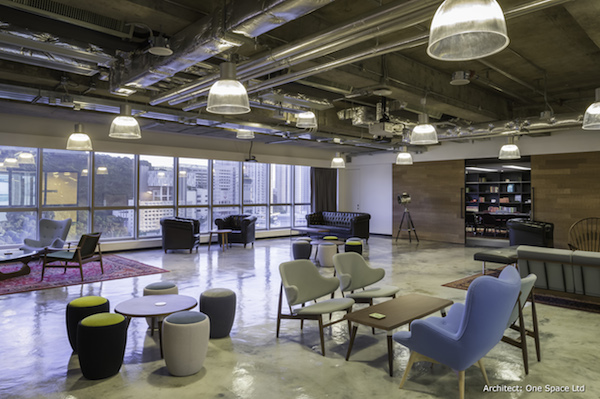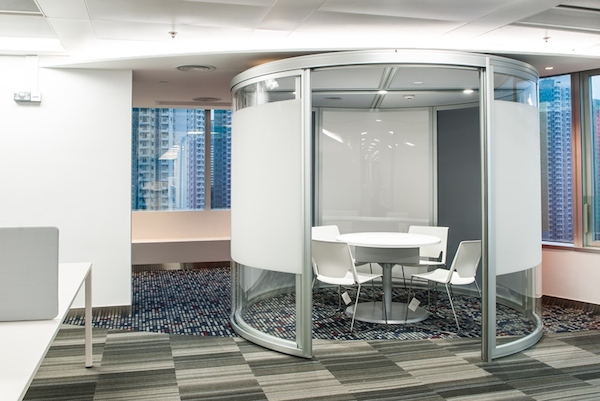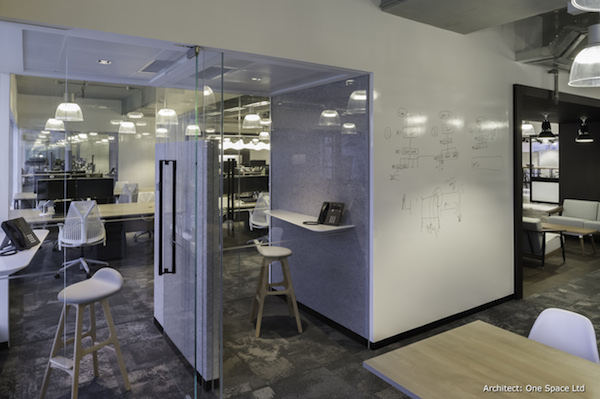Project management consultancy Merx shares know-how on corporate wellness and how this is shaping the spaces we work in. Paul Scroggie talks to Tamsin Bradshaw.

December 16th, 2015
Paul Scroggie is Director, Hong Kong, Macau and PRC, at Merx, an independent consultancy that specialises in project management, construction management, cost management and client representation. An architect with 28 years of experience behind him, Scroggie is well qualified to take a holistic approach to project management.
Merx was founded in Singapore in 2001 by William Forwood, on the premise that it would “facilitate space,” as Scroggie puts it, ensuring clients achieve project results that line up with their intentions as a brand. With offices in Hong Kong, Singapore, Kuala Lumpur, Jakarta and Myanmar, Merx has worked on projects everywhere from Shanghai to Yangon, and the company’s clients cross a spectrum of industries: Commerzbank, Barclays, Clifford Chance, Landor, Porsche Design and Qantas are just some of the names Merx has worked with. Here, Scroggie talks about the evolution underway in the workplace, and how it ties in to staff wellness.

Asurion Hong Kong. Merx was also responsible for delivering Asurion’s offices in Shanghai and Beijing, both based on workplace strategy developed by Scroggie for the Hong Kong office. One Space Ltd was responsible for the architecture
What’s happening in the workspace?
There’s greater emphasis on collaboration. The subtext to all this is that there’s an emphasis on brand. Organisations are starting to appreciate that the space they inhabit is a brand representation – and in the competitive marketplace, dealing with the generation of entitlement, brand offer is key.
The brand attributes, which physically manifest in a company’s workspace, also manifests in the focus on wellness that the company is taking – this reinforces the brand to internal stakeholders. I’m not talking about name and logo here; I’m talking about organisational brand for employees. In reality, it’s a new science. The industry is looking at it more and more.
What are you seeing at Merx? What are your clients doing?
Pretty much every office project we’re involved in has a component of flexible working implicit in it – all the way from flexible working hours to completely agile space. Maybe we’re the go-to people for this sort of project, but it’s also something that’s starting to happen all over the region. Australia is quite advanced in some sectors. China, meanwhile, is fast catching up, it will be way ahead very quickly.
What’s driving the change?
The international driver is cost: smart organisations are using this as an opportunity to introduce flexibility as a benefit to staff. That means different things to different people and different organisations. To one person, that means flexible working hours; to another, that may mean flexible work location. Whether you stay at home in the morning to get work done, then come into the office in the afternoon to have a meeting with people… as long as you get the job done, and you feel happier about doing it at the same time.

Rethinking meeting rooms: a movable room for Hang Seng Bank. Interior architecture by MAP Architecture
What are some of the features that are supporting wellness in the workplace?
Technology – it’s changing so rapidly. It was only a few years ago that we absolutely needed to have a desk phone. All of a sudden, the cost of a desk phone is gone, because you can migrate to a soft phone system. And these days, doing a regional video conference call on Skype is free, and you can patch people in from around the region, no matter where they are. This is a shift in technology that’s only two or three years old in terms of being really robust. When you get rid of the desk phone, you’re not beholden to place.

Phone booths at Asurion’s offices are part of the flexible workspace offering
Now, it’s also about hard wiring for offices: the standard approach now is, ‘Let’s connect through wi-fi,’ and then you don’t have to plug in your computer. You can be anywhere in the office and still be contactable and accessing servers. You can sit anywhere; at home, or in shared space in a cafe, or wherever it makes sense to sit at that particular time.
In addition, there are more spaces in which to collaborate, there’s more focus on ergonomics, and more spaces you can meet in that take a variety of formats – more bar stools, or you can relax on a couch. The paradigm of the meeting room is slowly being broken down; if you think about it, there are certain meetings that shouldn’t happen in a meeting room because they’d be better meetings if they didn’t.
Some organisations also have yoga rooms or access to gyms – that’s another physical manifestation of the wellness offering. I firmly believe that there’s a real imperative to move wellness forward. Shanghai is interesting: you can’t do a project there without staff asking about air quality. Every single project we have done there has involved an independent air quality assessment after construction. Staff are really focused on air quality and health, and they’ll stay away from the office if they’re not convinced.

Green walls enhance air quality at Schroders’ Singapore office
What do you think of data quantification in the workplace context?
I’m a huge fan of data and statistics, because I think you can then base real decisions on the findings. There is a reality, and it’s that 40 to 60 percent of the time, people are sitting at their desks. You could take a hardline view that 40 to 60 per cent of the time, these desks are empty and you could capitalise on that. But you can be much smarter about it: what are your staff doing the other 40 to 60 per cent of the time, and how can you support that? If you’re giving your organisation a competitive edge by enabling people to think more productively, then your organisation is all the better for it.
Merx
merxcm.com
INDESIGN is on instagram
Follow @indesignlive
A searchable and comprehensive guide for specifying leading products and their suppliers
Keep up to date with the latest and greatest from our industry BFF's!

Schneider Electric’s new range are making bulky outlets a thing of the past with the new UNICA X collection.

XTRA celebrates the distinctive and unexpected work of Magis in their Singapore showroom.

BLANCOCULINA-S II Sensor promotes water efficiency and reduces waste, representing a leap forward in faucet technology.

In this candid interview, the culinary mastermind behind Singapore’s Nouri and Appetite talks about food as an act of human connection that transcends borders and accolades, the crucial role of technology in preserving its unifying power, and finding a kindred spirit in Gaggenau’s reverence for tradition and relentless pursuit of innovation.
The internet never sleeps! Here's the stuff you might have missed

Trent Jansen shares his collaborative philosophy and passion for culturally connected design, speaking to the importance of storytelling, heritage and co-creation in his practice and award-winning project.

The extensive and impressive shortlist has been announced for this year’s Victorian Architecture Awards, with the Awards Night Dinner set to take place on Friday 27th June.